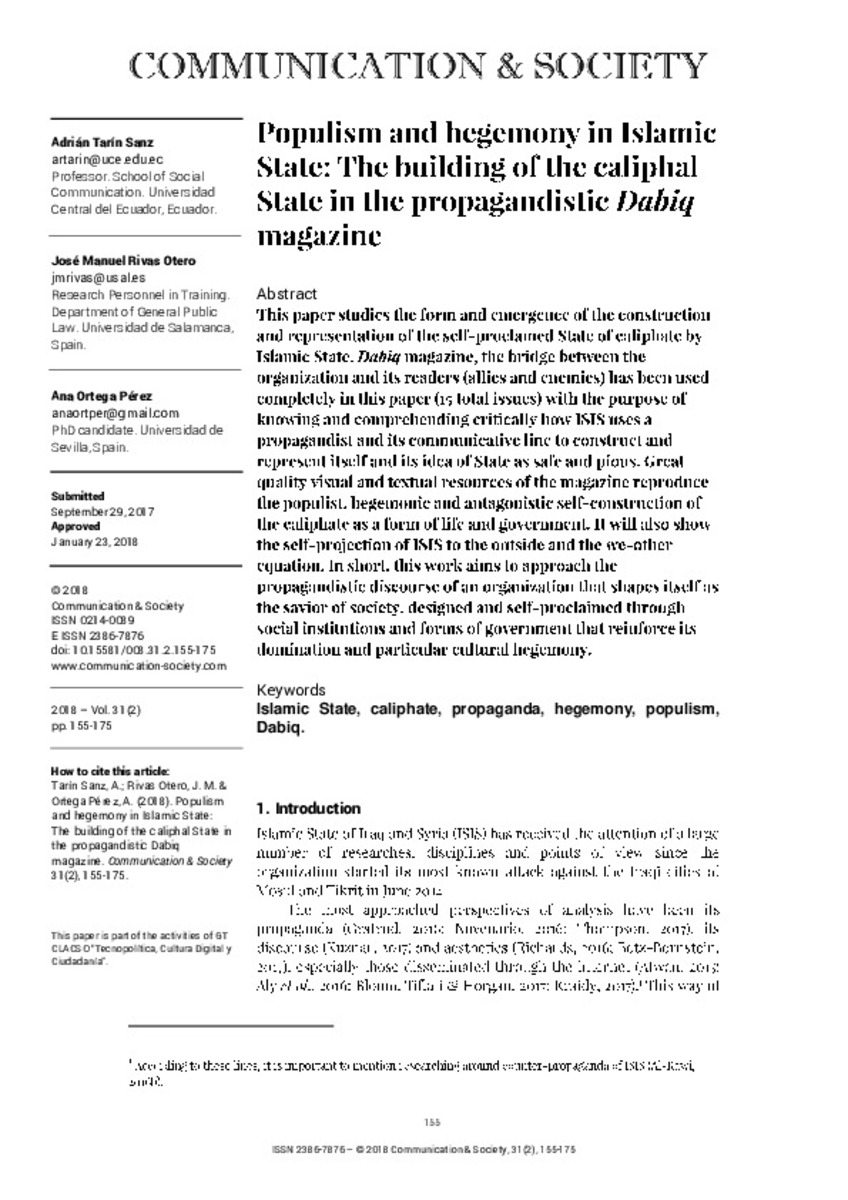Full metadata record
| DC Field | Value | Language |
|---|---|---|
| dc.creator | Tarín-Sanz, A. (Adrián) | - |
| dc.creator | Rivas-Otero, J. M. (José Manuel) | - |
| dc.date.accessioned | 2018-11-12T09:31:57Z | - |
| dc.date.available | 2018-11-12T09:31:57Z | - |
| dc.date.issued | 2018 | - |
| dc.identifier.citation | Tarín-Sanz, A. (Adrián); Rivas-Otero, J. M. (José Manuel). "Populism and hegemony in Islamic State: The building of the caliphal State in the propagandistic Dabiq magazine". . 31 (2), 2018, 155 - 175 | es |
| dc.identifier.uri | https://hdl.handle.net/10171/55762 | - |
| dc.description.abstract | This paper studies the form and emergence of the construction and representation of the self-proclamed State of caliphate by Islamic State. Dabiq magazine, the bridge between the organization and its readers (allies and enemies) has been used completely in this paper (15 total issues) with the purpose of knowing and comprehending critically how ISIS uses a propagandist and its communicative line to construct and represent itself and its idea of State as safe and pious. Great quality visual and textual resources of the magazine reproduce the populist, hegemonic and antagonistic self-construction of the caliphate as a form of life and government. It will also show the self-projection of ISIS to the outside and the we-other equation. In short, this work aims to approach the propagandistic discourse of an organization that shapes itself as the savior of society, designed and self-proclaimed through social institutions and forms of government that reinforce its domination and particular cultural hegemony. | es_ES |
| dc.description.abstract | El presente estudio analiza la construcción y de la representación del califato como Estado por parte del Estado Islámico. Para ello, se ha utilizado la revista Dabiq al completo. En el análisis se establecerá la forma en la que ISIS se autoproyecta hacia el exterior, incidiendo sobre todo en la ecuación nosotros-otros y nutriéndose de los imaginarios sociales y colectivos allegados a esta. En definitiva, este trabajo pretende acercarse al instrumento propagandístico de una organización que se plasma a sí misma como la salvadora de la sociedad y que, por ende, se ha diseñado y autoproclamado a través de unas instituciones sociales y unas formas de gobierno que refuerzan esa hegemonía cultural particular. | es_ES |
| dc.language.iso | eng | es_ES |
| dc.rights | info:eu-repo/semantics/openAccess | es_ES |
| dc.subject | Estado Islámico | es_ES |
| dc.subject | Califato | es_ES |
| dc.subject | Propaganda | es_ES |
| dc.subject | Hegemonía | es_ES |
| dc.subject | Populismo | es_ES |
| dc.subject | Dabiq | es_ES |
| dc.title | Populism and hegemony in Islamic State: The building of the caliphal State in the propagandistic Dabiq magazine | es_ES |
| dc.title.alternative | Populismo y hegemonía en el Estado Islámico: la construcción del Estado califal en la revista propagandística Dabiq | es_ES |
| dc.type | info:eu-repo/semantics/article | es_ES |
| dc.publisher.place | Pamplona | es_ES |
| dc.identifier.doi | 10.15581/003.31.35716 | es_ES |
| dadun.citation.endingPage | 175 | es_ES |
| dadun.citation.number | 2 | es_ES |
| dadun.citation.startingPage | 155 | es_ES |
| dadun.citation.volume | 31 | es_ES |
Files in This Item:
Statistics and impact
Items in Dadun are protected by copyright, with all rights reserved, unless otherwise indicated.






